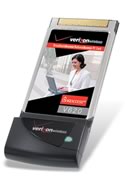Goodbye Wifi, Hello EV-DO - November 12, 2005
 Are you underwhelmed by the number of locations with solid WiFi access which you can actually use? Are you frustrated that the wifi signal strength at your coffee-shop hotspot is sub par? Have you spent time clicking through funky wifi billing pages only to be repeatedly disconnected while trying to use the network? Do you long to be able to use your laptop while in motion on a train or car? Throw out your WiFi and read on...
Are you underwhelmed by the number of locations with solid WiFi access which you can actually use? Are you frustrated that the wifi signal strength at your coffee-shop hotspot is sub par? Have you spent time clicking through funky wifi billing pages only to be repeatedly disconnected while trying to use the network? Do you long to be able to use your laptop while in motion on a train or car? Throw out your WiFi and read on...
My place of work has one of the most extensive in-office WiFi networks I've heard of. The ability to walk to nearly any places in the complex and compute has assured that nearly every employee has a WiFi laptop. However, even in this modern day WiFi Mecca, lost-connections and dead zones are an every day reality.
When venturing out into the world, my WiFi experiences have been even more sub-par. Finding a solid WiFi network, connecting and setting up the necessary billing is a task which I've found fails more often than it succeeds.
The San Francisco airport's T-Mobile service is one of the better WiFi hotspots. After a billing login is setup, repeat usage is relatively painless. However, the last time I tried it my laptop aimlessly hopped between channels without letting my traffic through. I finally decided to choose an A instead of G network, thinking that fewer people are operating on the higher-frequency, and voila my connection finally worked.
On a recent trip back from New York, I attemped to check email from LaGuardia. The local Concourse Communications billing page was only mildly annoying. However, after I went through the trouble of creating yet another login and password for them to bill me a measly $4.95, the network didn't even work. I pulled out my hardly-tolorable cellular EDGE card and suffered through the high-latency to send their customer care an email. They promptly refunded my payment. However, I longed for a better way.
That better way is here, and it's called EV-DO from Verizon Wireless.
During the last year, EV-DO has been rolling out in major US cities at an impressive rate. Both Verizon and Sprint have been lighting up cities, but until recently neither were available in my homedown. In August 2005, Verizon launched their EV-DO network in the San Francisco Bay Area. I rushed in to grab a PC Card (I have the V620), and have experienced a new sense of freedom ever since.
Despite what you read, this isn't about bandwidth, it's about latency. When you click on a web link, you want to see the next page arrive quickly. Most webpages are already quite small, so bandwidth isn't the issue, it's the length of time it takes for the round-trip of the data. While it turns out that higher-bandwidth services generally offer lower-latency, don't be confused. It's still the lower-latency which makes it work well.
| Service | Latency |
| GSM EDGE | 300-1500ms |
| CDMA EV-DO | 114-290ms |
Since I bought my EV-DO card, I've used my new freedom to do mobile computing in several cities, including San Francisco, New York, Minneapolis, Madison, and Portland. Looking for WiFi hotspots has been a thing of the past. Sure, I still use WiFi at work and home. However, when I'm mobile, I don't bother. I had a recent airport connection in Minneapolis during which I computed from the moment I opened my laptop in the waiting area through the moment they asked us to turn off electronic devices from the cabin. No billing signup, no $5 fees, no lost access points. In Portland I was able to compute productively both to and from the airport. Furthermore, the business I was visiting wasn't hooked up with open WiFi, making me the only visitor in the conference room with a working network.
If you need mobile high-speed data and you find WiFi just doesn't cut it, go get EV-DO from Verizon, you won't regret it.
* Sprint also offers EV-DO, due in San Francisco in 2006. Cingular is working on a rollout of GSM UMTS, which also offers high-speed low-latency data services, due out sometime in late 2006.
* Update 2/16/06: cnet's quick guide to 3G cell phone service
Posted by jeske at November 12, 2005 3:58 PM